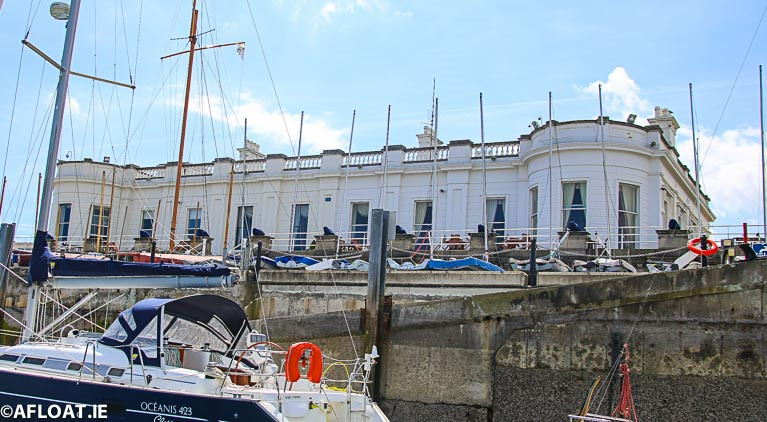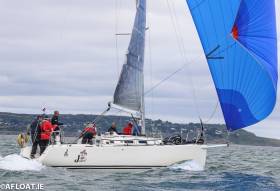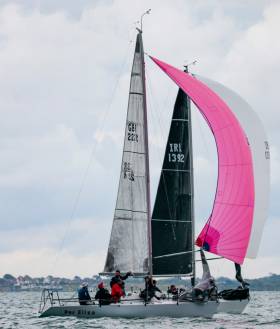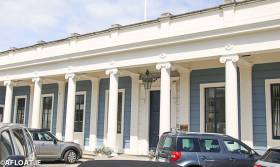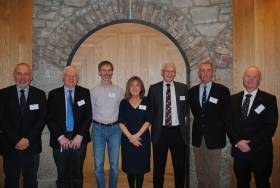Displaying items by tag: Royal Irish Yacht Club
Royal Irish Yacht Club Lift in of Yachts Planned for April 1st
The Royal Irish Yacht Club will be launching boats in less than a fortnight for the summer sailing season at Dun Laoghaire on Dublin Bay.
Details of the annual lift-in are contained in a bulletin to members that sets out arrangements for access to boats while the clubhouse is closed due to Coronavirus outbreak measures.
The RIYC boathouse is manned daily, 7 days a week 0930 -1730 hrs.
Crane services are also currently operational Monday to Friday 0930-1730 hrs.
As Afloat previously reported, the National Yacht Club lift-in is planned ten days later on April 11th, two weeks before the first DBSC races of summer season 2020.
Royal Irish Yacht Club to Stage 'Dun Laoghaire Cup', Ireland's Only 'Dedicated Sportsboat Event'
Ireland's only event 'dedicated to sportsboats', the Royal Irish Yacht Club will stage the inaugural 'Dun Laoghaire Cup' for six classes on May 16-17 as David O'Brien writes in this morning's Irish Times here.
The event incorporates the 1720 East Coast Championship, the SB20 East Coast Championship and the Beneteau First 21 National Championships. There will also be starts for the Dragons, J80 and J70 classes.
Up to six races will be sailed over Windward-Leeward and/or Trapezoid courses.
Download the Notice of Race below. Read more in the Irish Times here.
The host club's Joker 2 skippered by John Maybury leads the J109 National Championships after the first three races sailed from the Royal Irish Yacht Club today.
Racing in southerly winds gusting to 20-knots, poor visibility on Dublin Bay kept crews on their toes in the ten-boat fleet.
Second overall, and with a first race victory, is Pat Kelly's Storm II from Howth Yacht Club on seven points. Third, on the same points as Kelly is Maybury's clubmate Andrew Craig, the Scottish Series champion sailing Chimaera.
Maybury who sailed to his fourth consecutive ICRA national title back in June on the same race track looks set on adding the J109 national title too, winning two of today's three windward-leeward races.
But expect Storm to put up a fight in the second half of the championship tomorrow as Storms' tactician is Rob O'Leary, who was tactician on Andrew Algeo's "Juggerknot I" last year when they won both East Coast and National Championships.
Maybury has a new tactician this weekend with champion team racer Nicky Smyth replacing Cork Harbour Olympian Killian Collins.
Ryan Glynn, the current J24 National Champion, is tactician on Craig's "Chimaera", where the nucleus of his Scottish Series-winning team are still onboard.
Results here
Conor Gorman was the winner of the Laser 4.7 division of the JLL sponsored Royal Irish Yacht Club Junior Regatta yesterday.
The National Yacht Club sailor, who took third at the Laser Connaughts on Lough Derg at the weekend, emerged on top after three races in the six-boat fleet. Second was club mate Archie Daly with Ray O'Shea of the Royal Irish third.
In the RS Feva division, RSGYC's Charlie O'Riordan was the winner of the seven boat competition with Mark Fitzgerald second and Isobel Bloomer third.
Full RIYC Junior Regatta results are downloadable below
Royal Irish Yacht Club's Niall Dowling Launches New Quarter Tonner Per Elisa for Cup Competition in Cowes
The fifteenth edition of the revived Quarter Ton Cup got underway yesterday, and for the 19-strong fleet it was a tough opener.
Light winds of around 8 knots whispered into the sails, creating a game of tactics for the sailors. But that didn’t lessen the level of competition when racing eventually got underway, and the battle on the course raged with everyone keen to lay down their marker early on with just seconds separating the teams as they crossed the finish line.
Three races were sailed which saw five different boats claim finishes in the top three.
Ian Southworth’s Protis proved consistency is key, stealing the show on the opening day. Southworth, who finished fourth overall in the 2018 Quarter Ton Cup and second in 2017 racing Whiskers, opened the day with a win which he followed up with an impressive fifth and second place in the following races to lead overnight.
In the days opening race, Louise Morton’s Bullet finished just 26 seconds behind Southworth on corrected time, with Tony Hayward’s Blackfun a further 15 seconds back and RIYC's Niall Dowling’s newly launched Per Elisa taking fourth.
Remarkably, Per Elisa only hit the water for the first time this weekend, much to the surprise of Dowling’s wife and the skipper of Catch Olivia Dowling, as Niall explained: “We keep it a secret from my wife until the last minute, so the previous owner Richard Fleck kindly entered her. No one knew we had her until we came out yesterday for the practice race including my wife. I hope she has forgiven me – hopefully we’re not ahead of her or she may take that back. Our expectations for the week? Finish one place behind Catch!”
Luckily for Niall, Per Elisa is in 10th place after the first day, two places behind Catch after taking 10th and 13th in the days final two races.
By race two the breeze had built to 12 knots, which seemed to catch some of the fleet unawares with four boats OCS. This time it was Louise Morton who led to the first mark, but Sam Laidlaw and his newly christened BLT were not going to let Morton and her team have an easy ride, and by the first gate he had taken the lead. He held onto his advantage for much of the race, but a final surge by Morton saw her cross the line just 10 seconds ahead of Laidlaw on corrected time, with Julian Metherell’s Bullit taking third.
Much like the crew of Per Elisa, Laidlaw and his team first sailed the boat yesterday and any doubts that it would take them time to find their feet were well and truly quashed as they followed up their second place with a win in the third and final race - the boat which won the Quarter Ton Cup in 1980 showing its pedigree.
“It was exciting because we only put the boat in the water yesterday and we’re still trying to work out what the right rig settings are,” explained Laidlaw. “We didn’t get a very good start in the first race and we didn’t have the rig settings quite right. Then we got a bit more breeze in the afternoon and we really started to see what the boat can do. We’ve still got a lot to learn. If the weather gets windier we are in for some really exciting racing as this boat will go really well in the wind. She went like a rocket – I think she’s going to be quick.
Laidlaw finishes the day in third place, two points behind Morton and one-point clear of Julian Metherell.
The Quarter Ton Class is well known for its calibre of sailors and the diversity of its fleet. In the Corinthian division, Robert Stewart’s Hellaby had some promising results to lead the Corinthian rankings and currently sit seventh overall.
Racing continues until Wednesday 12th June, and the fleet are looking forward to a better forecast over the coming days with hopes of more wind and perhaps even a glimpse of the British Summer. For the full results, visit the website here
Changes on the Dun Laoghaire waterfront this season include a makeover to one of the most impressive facades in the centre of the harbour.
Few institutions surviving from the 1800s are older than the Royal Irish Yacht Club but this season in a move away from its traditional cream-coloured facade the oldest club in the harbour is sporting a new paint job, just in time for next month's Volvo Dun Laoghaire Regatta when the harbour will be en fete to welcome 3,000 sailors to the town.
As Afloat's WM Nixon previously reported here, the RIYC’s beautiful building is the world’s oldest purpose-built sailing clubhouse still precisely intact as originally designed completed in 1851 to the plans of John Skipton Mulvany and there’s no denying the sense of history kept alive with its elegant interior and impressive exterior.
This season the listed clubhouse, that retains to this day all its original architectural features, has opted for a discreet combination of light blue on the inner walls of the front facade with cream columns and a dark blue for the wooden sash windows, creating a greater sense of depth to the facade. Mr. Skipton would approve, surely?
Other decor projects on the waterfront are also underway. Starting into the scraping and painting routine (see below) is the Royal St. George Yacht Club. What colour are they going for?
 Work is underway on a new paint job at The Royal St George Yacht Club Photo: Afloat.ie
Work is underway on a new paint job at The Royal St George Yacht Club Photo: Afloat.ie
The Royal Irish Yacht Club in Dun Laoghaire is hosting an interactive session with Dublin Bay-based international race judge Gordon Davies on how you can best use the racing rules to your advantage.
The rule guru and international jury chairman will be on hand to answer your questions and give you plenty of insight into the world of racing rules.
The event will start this Wednesday at 1900 hrs in the RIYC Wet Bar. All are welcome but you must register here to attend, according to the RIYC website.
The running order for the talk will be:
- Right of Way at the Start line
- Room and Right of Way at the Windward Mark
- Room and right of Way at the Leeward Mark
J109 Jalapeno Wins Royal Irish Yacht Club Charity Race
There were 20 entries in a light southwesterly breeze for the Royal Irish Yacht Club's Annual Charity Race on Sunday, 30th December 2018
Race officers Henry Leonard and Paul McCarthy laid a triangle/sausage/ triangle course which was completed in an hours racing.
Line honours and the race win went to Jalapeño from the National Yacht Club helmed by Paul Barrington.
Second was another J109, Dear Prudence and third the J122 Gib & Tonic.
Just under €2000 was raised on the day for the RNLI.
Royal Irish Yacht Club Charity Race for December 30th on Dublin Bay
The Royal Irish Yacht Club will hold its Annual Charity Race on Sunday 30th December 2018
In aid of the RNLI Lifeboat Service, the warning signal for the keelboat race is 10.55.
Prizes will be awarded to first, second and third subject to entry numbers and be presented in the RIYC wet bar après sail where a hot dish will be available for all at €10 per serving.
Download the NOR below
Weather & Sailing Conference Attracts A Big Crowd at Royal Irish Yacht Club
The day-long Weather and Sailing Conference at the Royal Irish Yacht Club in Dun Laoghaire today is the first of its kind to be held in Ireland.
Attracting a large audience, the line-up of speakers at the yacht club draws on highly-qualified experts from both sides of the Irish Sea, and though much of the emphasis will be on weather conditions in Ireland, the conference is notably broad in its scope and variety of topics.
As Afloat.ie previously reported, the conference, organised by the Royal Institute of Navigation ( RIN) and the Irish Meteorological Society ( IMS) is supported by Dublin Port Company and runs until 5.30pm.
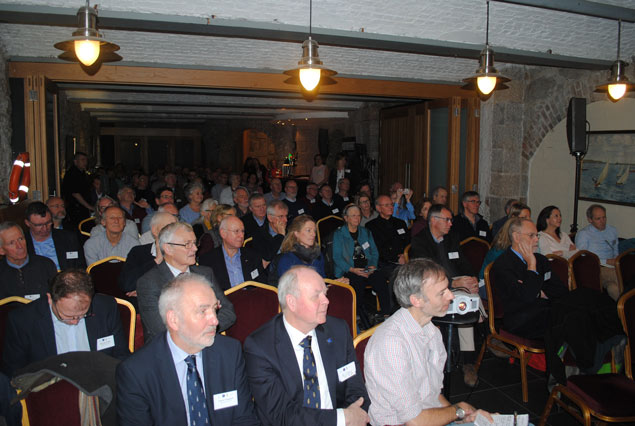 A large gathering for today's Weather Conference at the RIYC in Dun Laoghaire
A large gathering for today's Weather Conference at the RIYC in Dun Laoghaire


























